Köppen Climate Classification: Defining The Climate Zones Of The World
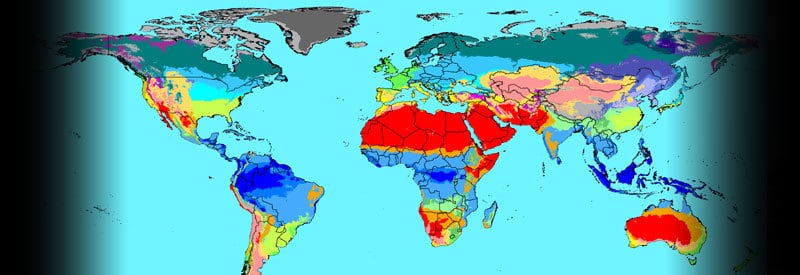
A region's vegetation primarily results from local, prevailing weather conditions, while the vegetation influences its climate in return. The Köppen Climate Classification system is based on this relationship.
The Köppen Climate Classification is a widely used meteorological classification system that divides global climate into five primary climate zones based on vegetation. It uses precipitation and temperature, the primary factors determining an area's vegetation type, to classify a region's climate.
The close correlation between climate and vegetation is evident in every part of the world. (The cold, dry conditions of Antarctica and the moist & humid conditions of the tropical rainforests in South America are just two examples of this powerful interaction.)
The strong connection between the two is also proving to play a key role in categorizing and dividing the global climate into more specific zones. Each climate zone is identified by its unique combination of vegetation, temperature, and precipitation.
These three variables are also determining factors in climate classification. During the late 19th Century, climatologist Wladimir Köppen used vegetation, temperature, and precipitation as the key components in developing the Köppen Climate Classification.
This post describes what the Köppen Climate Classification is and also looks at the different climate zones it defines.
Köppen Climate Classification Definition
It is already clear that vegetation, temperature, and precipitation are the three main components involved in defining the Köppen Climate Classification.
Before looking in more detail at the different climate regions identified by this system, as well as the role each component play, one needs to obtain a clear and concise definition first of what the Köppen Climate Classification is:
What Is The Köppen Climate Classification?
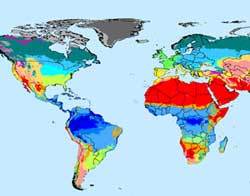
The Köppen Climate Classification is a widely used meteorological classification system that divides global climate into five primary climate zones based on vegetation. It uses precipitation and temperature, the primary factors determining an area's vegetation type, to classify a region's climate.
The close correlation between climate and vegetation, already mentioned in the introduction, forms the basis for this popular classification system.
Late in the 19th century, climatologist and botanist Wladimir Köppen developed a climate classification system based on vegetation. He used the correlation between vegetation and climate in different regions to divide the world's climate into specific zones.
The resulting Köppen Climate Classification categorizes the global climate into five distinct zones, primarily based on the temperature and precipitation experienced by each one.
Köppen continued to change and refine his classification system, with two of the most important amendments made in 1918 and 1936.
Climatologists continued to make amendments to Köppen's climate classification. Rudolf Geiger was probably the most influential in making important amendments, and the subsequent Köppen-Geiger Classification System is one of the most widely used today.
Climate Zones Of The World
According to the Köppen Climate Classification, the global climate can be divided into five primary zones. These climate zones are based on regional vegetation and are defined by the temperature and precipitation that are responsible for its formation.
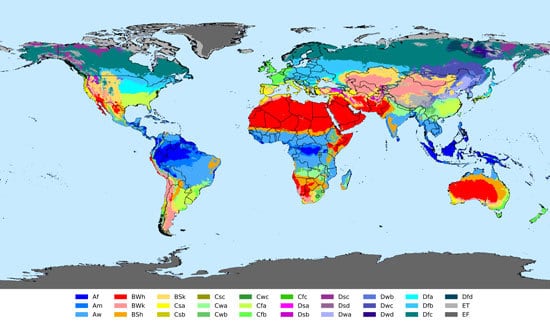
Köppen-Geiger Climate Map depicting the 5 major climate zones and subcategories
The zones are defined by the capital letters A, B, C, D, and E. The climate zones defined by each letter are:
A) Tropical Climates
B) Dry Climates
C) Temperate Climates
D) Continental Climates
E) Polar Climates
Each of the five major climate zones covers a vast region and is divided into smaller categories to describe the more specific climate types within each zone.
The best way to understand each climate type and its characteristics is to look at it within the primary climate zone in which it falls.
A) Tropical Climates
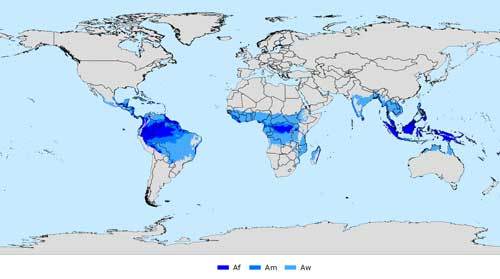
Tropical (also known as equatorial) climates occur in regions situated around the equator and expand to latitudes of 15° to 25° to the north and south. It can be defined by the following characteristics:
This zone is divided into three subcategories, which are classified according to temperature and dryness.
- 1Af - Tropical Rainforest Climate (no dry season.)
- 2Am - Tropical Monsoon Climate (short dry season)
- 3Aw/As - Tropical Savanna Climate (winter dry season)
B) Dry Climates
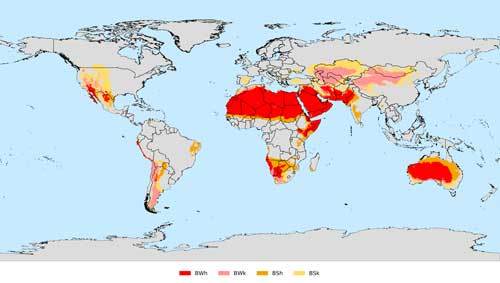
Dry (or arid) climates occur in regions situated at latitudes between 20° to 35° north and south of the equator. It can be defined by the following characteristics:
This climate zone is divided into desert (BW) and semi-arid (BS) regions, according to vegetation type. It is further categorized into hot (h) and cold (k) zones:
- 1BWh - Hot Desert Climate
- 2BWk - Cold Desert Climate
- 3BSh - Hot Semi-Arid Climate
- 4BSk - Cold Semi-Arid Climate
C) Temperate Climates
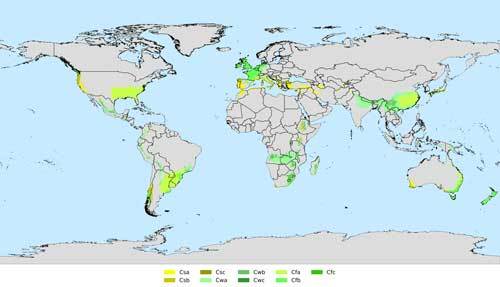
Temperate (or mesothermal) climates occur in regions situated at latitudes between 30° to 50° north and south of the equator. It can be defined by the following characteristics:
Temperate climate zones are divided into three main categories according to precipitation: mild temperate dry winters (Cw), mild temperate dry summers (Cs), and mild temperate humid (Cf) climates. All three subcategories are further divided according to temperatures:
- 1Cfa - Humid Subtropical Climate
- 2Cfb - Temperate Oceanic Climate
- 3Cfc - Subpolar Oceanic Climate
- 4Csa - Hot-Summer Mediterranean Climate
- 5Csb - Warm-summer Mediterranean
- 6Csc - Cold-summer Mediterranean Climate
- 7Cwa - Monsoon-Influenced Humid Subtropical Climate
- 8Cwb - Subtropical Highland Climate
- 9Cwc - Cold Subtropical Highland Climate
D) Continental Climates
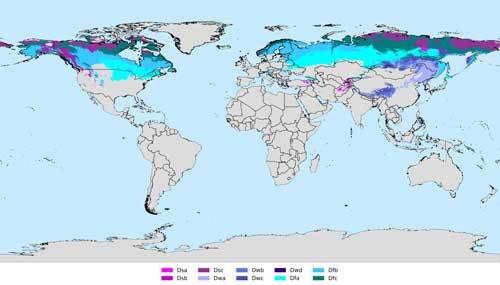
Continental climates typically occur in regions situated at latitudes between 40° and 75° north and south of the equator. (Although this type of climate is rare in the Southern Hemisphere.) It can be defined by the following characteristics:
Continental climate zones are divided into three main categories according to precipitation: continental dry summer (Ds), continental dry winter (Dw), and continental humid (Df) climates. Like temperate climates, they are further divided according to temperature:
- 1Dfa - Hot-Summer Humid Continental Climate
- 2Dfb - Warm-Summer Humid Continental Climate
- 3Dfc - Subarctic Climate
- 4Dfd - Extremely Cold Subarctic Climate
- 5Dsa - Hot Dry-Summer Continental Climate
- 6Dsb - Warm Dry-Summer Continental Climate
- 7Dsc - Subarctic Climate
- 8Dsd - Very Cold Subarctic Climate
- 9Dwa - Monsoon-Influence Hot-Summer Humid Continental Climate
- 10Dwb - Monsoon-Influence Warm-Summer Humid Continental Climate
- 11Dwc - Monsoon-Influence Subarctic Climate
- 12Dwd - Monsoon-Influence Extremely Cold Subarctic Climate
E) Polar Climates
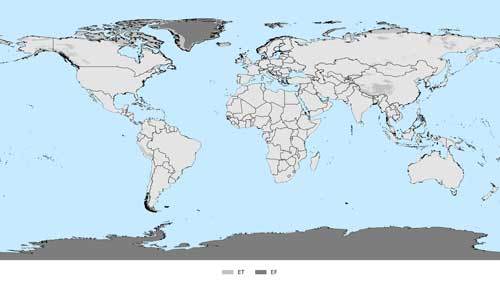
Polar climates are located at latitudes above 70° over the Arctic, Greenland, and Antarctica. It is characterized by its all-year-round cold temperatures and little to no vegetation. The following characteristics define it more precisely:
Polar climates are divided into two categories according to vegetation:
- 1ET - Tundra
- 2EF - Ice Cap Climate
Tundra Climates consist of very little vegetation (mainly loose shrubs, mosses, and dwarf trees) over a surface where the soil is frozen for several hundred meters. (A condition known as permafrost.) Ice Cap Climates are completely covered by ice or snow.
Conclusion
As clearly illustrated throughout this article, several smaller climate regions exist within each of the five major climate zones. Vegetation, temperature, and precipitation have been the key factors used in determining each subcategory.
Most countries throughout the world experience multiple sub-climates, and many larger regions are influenced by five or more different climate types at any given time. To explain all the climate zones affecting every country/region, though, will fill an encyclopedia.
This post provided a broad and thorough overview of the five climate regions as defined by the Köppen Climate Classification. It highlighted the characteristics of each one, as well as laying out their subcategories and how they were defined.
Never miss out again when another interesting and helpful article is released and stay updated, while also receiving helpful tips & information by simply following this link .
Until next time, keep your eye on the weather!
